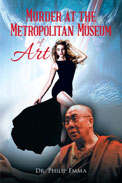
 |
Eccentric genius Mick Maux (pronounced "mouse") struck it rich as a scientist and professor and retired with rare luck. Now he freelances as a private detective. His cases allow him to continue to exercise his vast intellect, and the latest mystery in which he finds himself embroiled is no exception. Peter Pettanko, a Wall Street tycoon and amateur art collector, hires Mick to find his missing glamorous ex-model wife. That night, Pettanko suddenly dies. Officially, a heart attack killed him, but Mick, who swears he sees Titiana, Pettanko's wife, enter the estate as he is leaving, disagrees.
A gorgeous young woman would have a motive to dispatch her much older rich husband. The real mystery seems to be the identity of the robed Tibetan monk Mick sees with Titiana. Did he kill Pettanko? Mick learns that Titiana's disappearance is one facet of an art theft ring that steals original art from museums and sells it in the growing Chinese market for Western art. To solve the case, Mick must allay any suspicions of those involved. Sometimes this means hilariously learning how to meditate at a bogus retreat or taste-testing a Slurpee whose recipe is a secret at a shady 7-Eleven. At other times and at great personal risk, Mick harbors priceless original paintings in his home. And when he realizes nothing is beneath an unscrupulous art appraiser who tries to cheat his best friend, Mick knows the best punishment he can administer is the most illegal, most permanent punishment of all.
With the character of Mick, Emma has created a highly articulate art enthusiast who eloquently describes prints of such masterpieces as Fragonard's The Swing, Pollock's One: Number 31, Grun's The Dinner Party, Mondrian's Composition with Red, Blue, and Yellow, Magritte's The Son of Man, and, most notably, L'Absinthe by Degas. Mick describes the color composition of each piece and the subtleties of line angle and shadow. He supplements this with his commentary about the social conditions of the time in which each work was rendered. For instance, he reflects that when Degas painted L'Absinthe, absinthe did not, as it does today, cost fourteen dollars per glass. Elsewhere, he remarks that in its time, The Swing would have been considered scandalous because it reveals a woman's frilly undergarments and features her lover overtly pointing to her crotch in the very presence of her husband. Photographs of each painting mentioned accompany and augment the novel's text.
Emma successfully imbues Mick with scientific expertise like his own. Both author and protagonist are retired teachers. Mick also shares Emma's passion for fine cuisine, which the latter acquired during a stint as a sous-chef. Indeed, Mick describes his dining experiences at numerous restaurants as lyrically as he does his beloved paintings. He clearly considers good food yet another art form. In one scene, he describes the smoky taste of eel and the way Riesling compliments it. In another, he tells of the succulence of lobster and rare chateaubriand and how Stag's Leap is an excellent choice to pair with them. Those who appreciate the sarcastic humor of a cultured, narcissistic genius and share his fondness for artistic masterpieces will enjoy this book. So will those who gravitate to literary protagonists who commit serious crimes for the greater good.